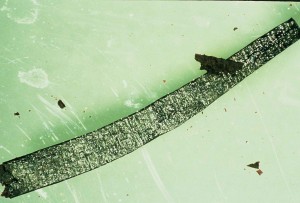by Zhiji Ou
The Cambrian explosion is one of the most well known events in Earth history, during which most major modern metazoan phyla appeared. Prior to the Cambrian explosion (namely in the Precambrian, the largest time span in Earth’s history) animals were scarce, skeleton-less, and weird looking. Although a few of them may show similar morphology to modern sponges, comb jellies and jellyfish, the majority represent unknown clades which are believed to have died out. During the transition from the Precambrian to the Cambrian, there were quite a few fossils, which look similar to some creatures living today. They are not easily placed in the tree of life tree just because of their simple appearances. One of these enigmatic organisms is called Sabellidites cambriensis.

Sabellidites was a tubular animal that lived about 542 million years ago. It has a pure-organic tube, giving it a black and sometimes shiny look. The surface of the tube is either smooth, with fine furrows or wrinkles. The characteristically wrinkled tubes are 0.2–3.0 millimeters wide and up to 16 cm long. But flattening always happened during burying, so most of the Sabellidites fossils have a ribbon-like rather than a tubular appearance.
This fossil was first found by a former Soviet Union scientist named Yanishevskii in 1925 in Petrograd, USSR. Later on, researchers claimed the occurrences of Sabellidites in other parts of the East European Platform, China, Serbia, Canada and northern Scandinavia. Contemporaneous to Sabellidites are other diverse animals, which have a hard bio-mineralizing skeleton, such as Sinotubulites, Cloudina, Namacalathus and Nama-poikia. Quite different from them, Sabellidites is unique for its organic tube The tube has discrete layers composed of differently orientated fibers embedded in an amorphous matrix. What´s more, evidence from biogeochemistry shows that this organic tube contains β chitin. The closest animal, which has both β chitin and similar morphology of the tube, is the family Siboglinidae. Thus some scientists group Sabellidites as an extinct member of the family Siboglinidae within the phylum Annelida.
Siboglinidae, also called beard worms, are composed of about 100 tubular species, which live in sediments at ocean depths from 100 to 10,000 meters. Most siboglinids are less than 1 millimeter in diameter but 10–75 centimeters in length. The tubes are often clustered together in large colonies. The worms have a complex closed circulatory system and a well-developed nervous system, but as adults, siboglinids lack a functional mouth, gut and anus. But that does not mean adult siboglinids can survive without assimilating any nutrients. These worms derive energy from a special storage organ, which is called a trophosome. Tons of microbes live here and produce enough organic matter for their hosts. Siboglinids are dioecious, which means each individual is either male or female. The fertilized eggs hatch to produce small paramecium-like larvae. But after they grow up, they lose the ability of free movement and become sessile.

However, there are still a lot of unsolved puzzles and debates about this fossil. Recently, scientists from all over the world gathered in Tromsø (Norway) and Uppsala (Sweden) to study and discuss the morphology, phylogeny, taphonomy and palaeo-ecology of Sabellidites from the Digermulen Peninsula and the East European Platform.

confusing site and I search dumbfounding article outlining Gurgaon Escorts thought read the sex about took to this article.